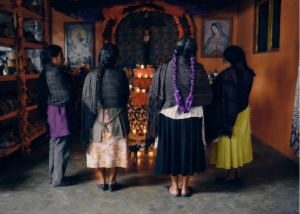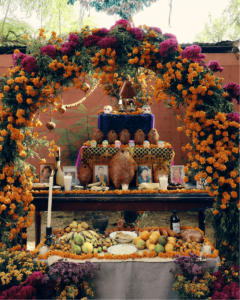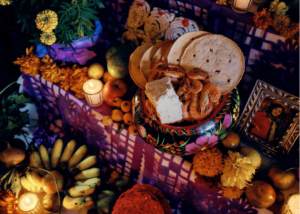The Day of the Dead is an ancient tradition. It extends throughout Mexico and various Latin American countries. It’s a festivity listed as Intangible Cultural Heritage with different influences—including European ones— that has one purpose: During one or several days, we remember those who are no longer with us.
The origin of the Day of the Dead cannot be located in a single place in Mexico. The consensus among historians is that the traditions dedicated to the deceased date back to pre-Hispanic times. More than two thousand years ago, various cultures ranging from the Mexica to the Zapotec worshipped death, sending off those who passed to Mictlán, the Aztec underworld containing the nine circles of Hell that souls must go through until they reach peace.
The pre-Hispanic ritual of sending off the dead included sacrifices and offerings for them to carry during their journey. Specialists have also discovered that in Europe tributes were offered to anonymous martyrs as well. The Conquest of Mexico generated an interesting cultural fusion: Catholic images mixed with pre-Hispanic elements, such as skulls, copal, marigold flowers, or traditional food that varies based on the region where the altar is placed.
Among the elements that distinguish the Day of the Dead is the classic bread of the dead, which highlights the ancestral gastronomic knowledge of countless regions, with the flavor and style of a piece varying according to the place where it’s made. The traditional design, with sugary bones and a circular shape at the center, also has a colonial origin—it symbolizes the human sacrifices that were made in pre-Hispanic cultures. The bone-like figures represent the extremities, and the circumference represents the head or heart, depending on the legend.
Why is death celebrated with folklore in Mexico? It is the end of one cycle and, within the ancestral worldview, the beginning of another. Those who leave want to be remembered with joy, as a traditional song from the Isthmus of Tehuantepec, “La Martiniana,” says, “Don’t cry, no. Because if you cry, I suffer. Whereas, if you sing to me, I always live and never die.” Mexican homes receive their departed loved ones every year with marigold flowers, papel picado, the scent of copal and traditional food such as mole, fruits and bread.
How is the Day of the Dead celebrated in Oaxaca?
“Cuúl, mam, guquín yuvituu te cop niss wuvadauu naá rivees yúbitu con dunuun,” says Viviana Alavez in her native Zapotec language. It means “Grandfather, grandmother, have a glass of mezcal now that you are with us.” The copal resins, which have already been fused with the incandescent coal, cause a smoky and aromatic effect that announces the arrival of those who have left, but who return every November 1st and 2nd to the homes of those who remember them. Viviana, along with her daughters-in-law, Petra and Guillermina, line up the chairs where relatives and acquaintances will sit and visit the altar built in the main room for worshipping saints, which is located in their house/workshop in Teotitlán del Valle, in the state of Oaxaca, southeast of Mexico. Itzel Bibiana, her granddaughter, sets out the mats on which the souls will rest in order to enjoy the banquet that has been prepared in their honor. Yellow tamales wrapped in corn husks, the traditional bread of the dead, fruits, chocolate-atole, and livers with egg are just some of the foods that are specifically cooked to rejoice the souls that return. Now, on November 1st, we just have to wait for the church bells to chime at 3:00 p.m., for the fireworks, and for that slightly cold wind that announces that it is time to open the doors of the house to let them in.
In Santa María Atzompa, Valles Centrales, the Ruiz López sisters orchestrate a parade of flowers that soon illuminate the family altar with color: Yellow marigold flowers and lush rooster combs in fiery red, “give light to the deceased, illuminating their path,” explains Rufina, a teacher. The white Calla Lilies signifies the purification of the soul and the purple flowers emphasize mournings. Underneath the staircase-shaped structure and behind the yellow petals, there is a rug that captures the deadly image of the feathered dancer’s face, a character from one of the main Oaxacan folk dances. It is outlined by rice seeds and decorated with red corn kernels, beans, lentils, and pumpkin seeds, which also offer a tribute to Mother Earth, who feeds us. Under the pottery tradition that surrounds the Ruiz López space, there are two clay skulls illuminated with candles that join the light and invite the contemplation of life beyond death.
Inside her house, Esperanza Deyanira Aquino Pineda, La Teca, opens her old trunk. From it she extracts a cap embroidered with white flowers that stand out on her deep black huipil and skirt. The striking outfit is adorned with earrings and a gold necklace worked in the traditional Isthmian filigree technique. She places the last details on the altar––a majestic installation of seven steps, “the phases of life that guide all human beings,” says Deyanira––which is crowned with the Virgin of Guadalupe under an arch of banana leaves. The traditional Isthmian jicalpextles overflow with chips, cheese, and dried shrimp, and rival in color the marquesote decorated with fretwork motifs and the names of the deceased. There, the conversation between the living and the dead is tinted with rich colors and a complexity of aromas and flavors, but always foregrounds worship and devotion, since “it is a moment of reflection for those of us who remain alive,” responds the La Teca.
Uveira Cruz Soriano is the matriarch of the Ortiz Cruz family, a lineage that comes from the high and low Mixtec region of Oaxaca. In this family, the setting of the altar of the dead strengthens generational ties. Grandparents, children, daughters-in-law, and grandchildren make communion in a tradition as deeply embedded as the roots of the Mixtec maguey, and agave plant. Curiously enough, the roots of the maguey are the material in which the image of the Virgin of Juquila (standing out from the family altar honoring Mrs. Uveria’s brother, her daughters-in-law’s aunts and grandmothers, and her parents-in-law) is carved. Her husband’s family is responsible for providing the main dish of the offering: A light stew made of olives, served with a piece of chicken and white rice. This dish starts the party, “like in any Oaxacan home, which reflects who we are in an authentic way,” emphasizes Mrs. Uveira, who uses the memories of her father-in-law to bring back conversations and to give them music with melodies that the honored deceased enjoyed, while awaiting their arrival on November 1st.
Long braids, high-flying skirts, and flower baskets are carried as banners of pride on their heads, which are some of the characteristics that distinguish the Chinas Oaxaqueñas. The particularities of the aesthetics of these hurdlers wouldn’t have been possible without the inspiration of their founder, Doña Genoveva Medina, who dedicated most of her life to carrying on this traditional dance, and the identity of her beloved Chinas. Within the framework of the Day of the Dead festivities, the rainbow of hues in the flowers is replaced by the majestic yellow of the marigold flowers. Simultaneously, the color of the skirts of the Chinas Oaxaqueñas is changed to black, to represent mourning and respect for those who have already left but who continue to enjoy—along with us—the traditional sounds with which the beautiful dancers start off the festivities in the city of Oaxaca de Juárez: The wish that Doña Genoveva, undoubtedly, would have wanted to never be forgotten.
The temperature of the oven provides a warm environment for the preparation of various doughs and ingredients that produce breads of popular tradition. However, during the Day of the Dead there is one that stands out for its deep meaning on Oaxacan tables and altars: the bread of the dead. Doña Dionicia Aldeco Alejandrez, born in San Juan Tonaltepec, Oaxaca, learned the art of breadmaking through her husband. In her mastery acquired through decades of breadmaking, she keeps that recipe not written in her mind, but actually always present in this holiday through the making. Talking about the bread of the dead in Oaxaca implies a diversity as extensive as its communities, since each one of them makes the bread in different ways according to their traditions. However, for Doña Dioni the recipe translates into a know-how that implies respect for those who buy it and those who prepare it for the family. The elements that are mixed in this baking alchemy are eggs, wheat flour, water, butter, sugar, salt, anise, butter, and her favorite ingredient, cinnamon. The next step is to sprinkle them with sesame seeds––“A lot of sesame, as they like it here in the valley!” blurts out Doña Dioni––crown them with the colorful faces of saints in crumbs, and then put them into the oven, remove them carefully, and enjoy them by dipping them by chunks in hot chocolate, a pleasure that delights both the living and the dead.
DP: Arturo Lavariega Creative Director: Enrique Torres Meixueiro Vogue Editors: Atenea Morales, Cristina Chamorro
Translated by Paulina Carvajal y Thalia Henao. Edited by Alejandra Cuevas, Chloe Schama.










